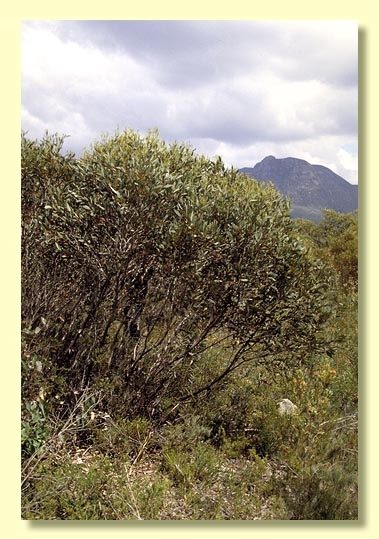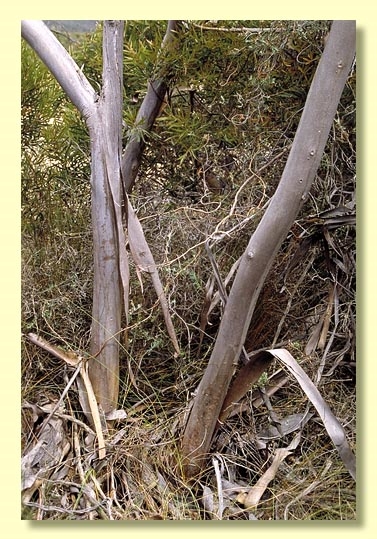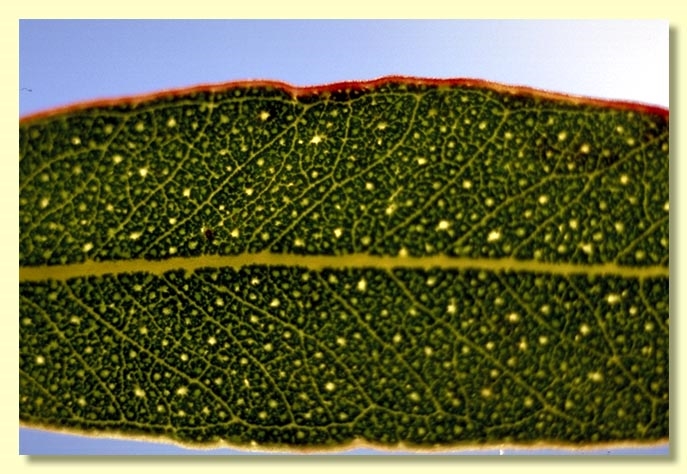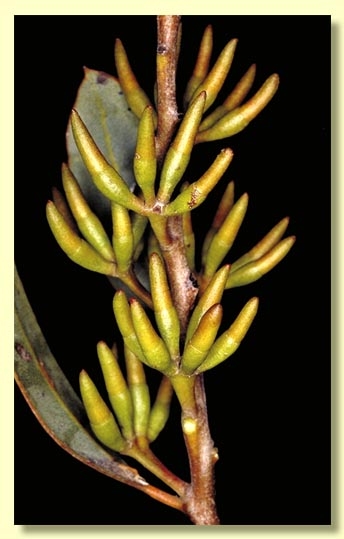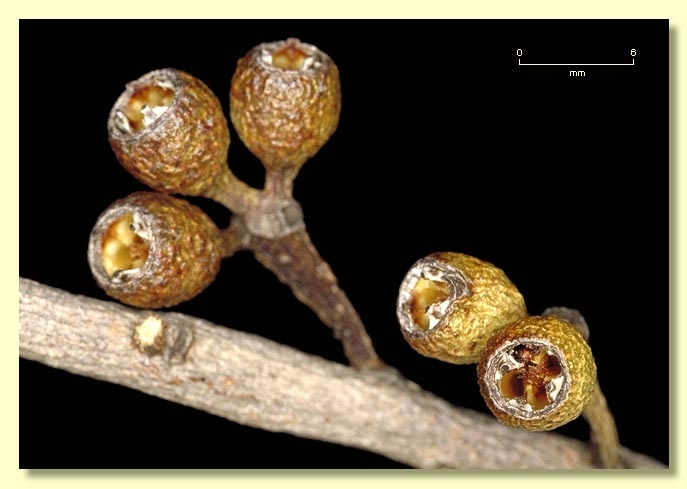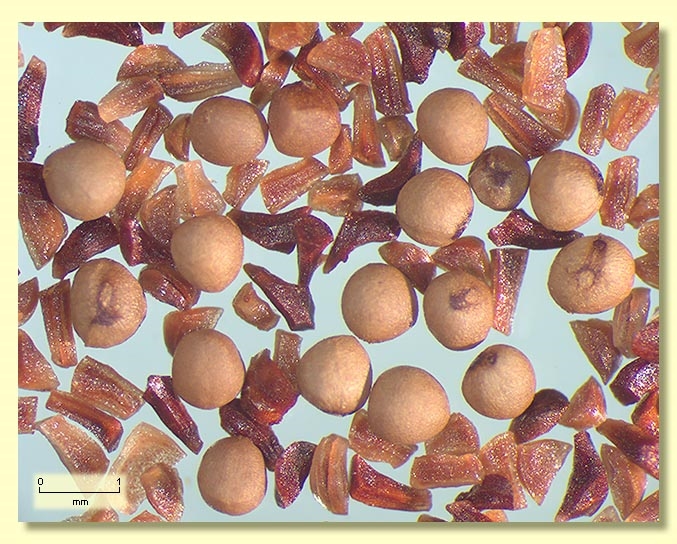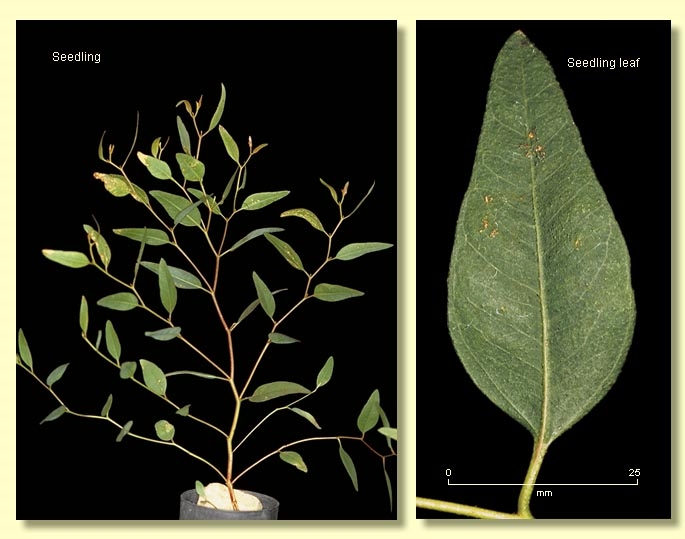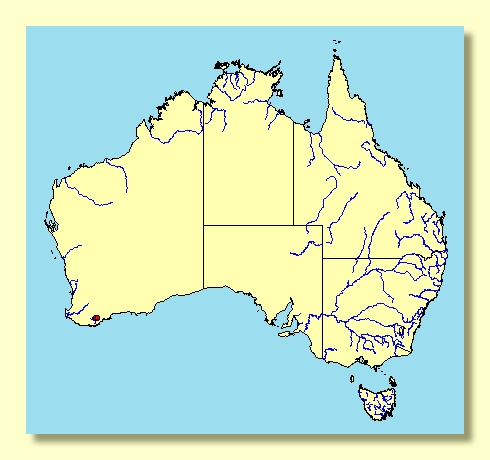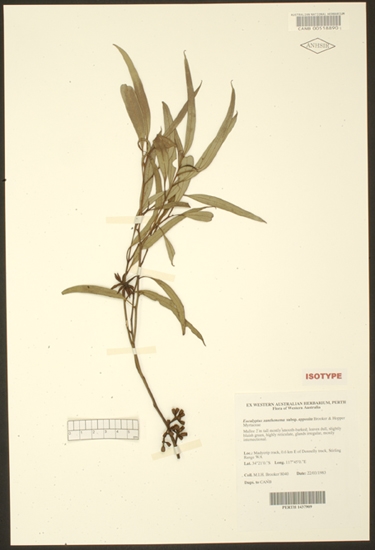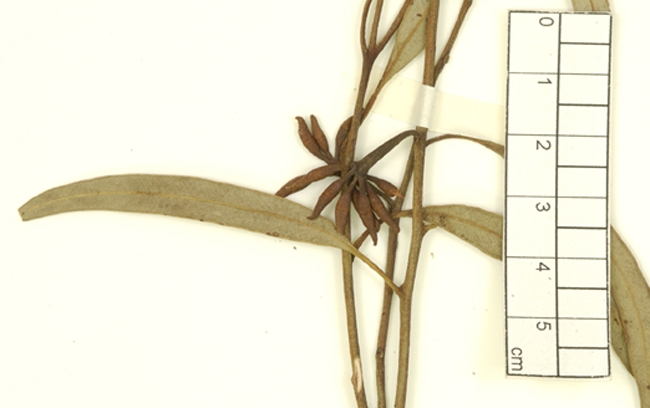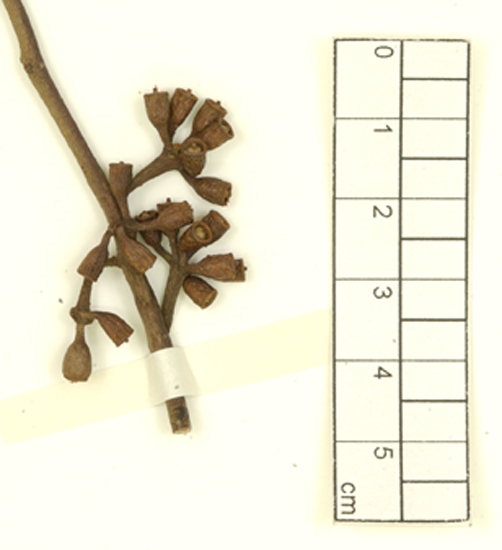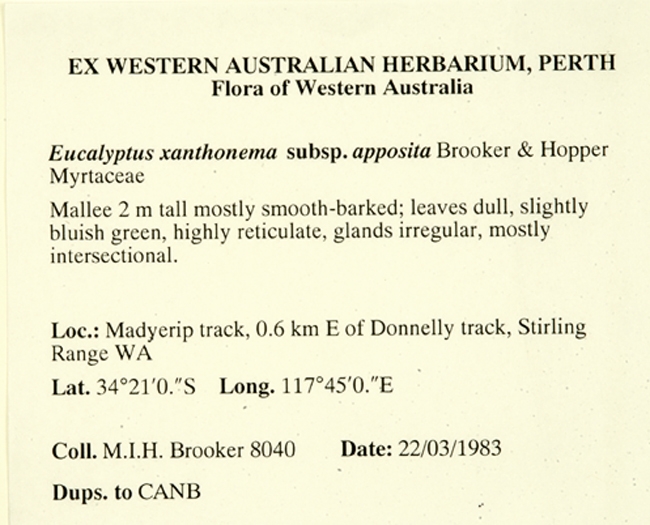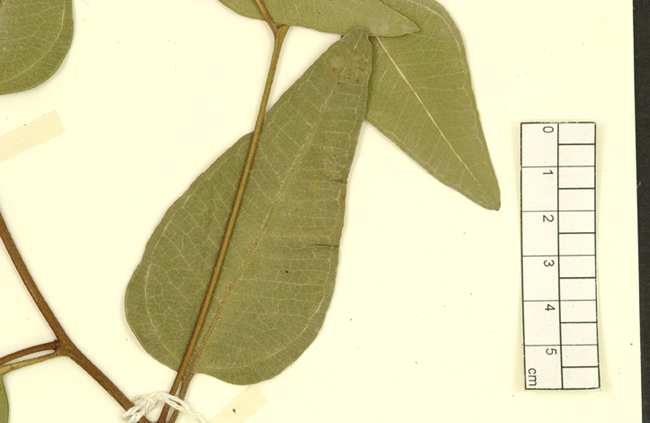Eucalyptus | Symphyomyrtus | Bisectae | Glandulosae | Levispermae | Cubiformes
Euclid - Online edition
Eucalyptus xanthonema subsp. apposita
Classification
Nomenclature
Description
Mallee to 3 m tall. Forming a lignotuber.
Bark smooth throughout, grey-brown and light grey over pinkish or light orange to cream, grey ribbons may shed tardily at the base.
Branchlets have oil glands in the pith.
Juvenile growth (coppice or field seedlings to 50 cm): not seen.
Adult leaves alternate, petioles 0.5–1 cm long; blade lanceolate to falcate, 4–6.5 cm long, 0.7–1.5 cm wide, base tapering to petiole, margin entire, apex acute, concolorous, dull, grey-green to light green, side-veins greater than 45° to midrib, reticulation usually sparse or obscure, intramarginal vein present, oil glands island, irregularly-shaped.
Inflorescence axillary unbranched, peduncles widen apically, 0.9–1.3 cm long, buds ?9 to ?15, pedicellate (pedicels 0.2–0.4 cm long). Mature buds fusiform (1–1.3 cm long, 0.3–0.4 cm wide), scar present, operculum narrowly conical, to twice the length of the hypanthium and equal to it in width at the join, few outer stamens erect, most stamens variably deflexed, anthers oblong, versatile, dorsifixed, dehiscing by longitudinal slits, style long and straight, stigma blunt to tapered, locules 3, the placentae each with 4 vertical rows of ovules. Flowers white to pale lemon.
Fruit pedicellate (pedicels 0.2–0.3 cm long), cylindrical to barrel-shaped, 0.6–0.7 cm long, 0.4–0.6 cm wide, disc descending vertically, valves 3, near rim level.
Seeds pale brown to straw-coloured, 0.8–1.3 mm long, usually sub-spherical, surface smooth, hilum ventral/terminal.
Cultivated seedlings (measured at ca node 10): cotyledons Y-shaped (bisected); stems rounded in cross-section; leaves always petiolate, opposite for ca 3 nodes then alternate, ovate-lanceolate, 4.5–8 cm long, 1.3–4 cm wide, grey-green becoming green at upper nodes, dull.
Bark smooth throughout, grey-brown and light grey over pinkish or light orange to cream, grey ribbons may shed tardily at the base.
Branchlets have oil glands in the pith.
Juvenile growth (coppice or field seedlings to 50 cm): not seen.
Adult leaves alternate, petioles 0.5–1 cm long; blade lanceolate to falcate, 4–6.5 cm long, 0.7–1.5 cm wide, base tapering to petiole, margin entire, apex acute, concolorous, dull, grey-green to light green, side-veins greater than 45° to midrib, reticulation usually sparse or obscure, intramarginal vein present, oil glands island, irregularly-shaped.
Inflorescence axillary unbranched, peduncles widen apically, 0.9–1.3 cm long, buds ?9 to ?15, pedicellate (pedicels 0.2–0.4 cm long). Mature buds fusiform (1–1.3 cm long, 0.3–0.4 cm wide), scar present, operculum narrowly conical, to twice the length of the hypanthium and equal to it in width at the join, few outer stamens erect, most stamens variably deflexed, anthers oblong, versatile, dorsifixed, dehiscing by longitudinal slits, style long and straight, stigma blunt to tapered, locules 3, the placentae each with 4 vertical rows of ovules. Flowers white to pale lemon.
Fruit pedicellate (pedicels 0.2–0.3 cm long), cylindrical to barrel-shaped, 0.6–0.7 cm long, 0.4–0.6 cm wide, disc descending vertically, valves 3, near rim level.
Seeds pale brown to straw-coloured, 0.8–1.3 mm long, usually sub-spherical, surface smooth, hilum ventral/terminal.
Cultivated seedlings (measured at ca node 10): cotyledons Y-shaped (bisected); stems rounded in cross-section; leaves always petiolate, opposite for ca 3 nodes then alternate, ovate-lanceolate, 4.5–8 cm long, 1.3–4 cm wide, grey-green becoming green at upper nodes, dull.
Flowering Time
Flowering time unknown.
Notes
Eucalyptus xanthonema is a species of mallee endemic to the south-west of Western Australia, widespread from Williams to the Stirling Range and Fitzgerald River National Park. The stems are smooth-barked, the adult leaves dull, light green and buds elongated with the operculum drawn out to a fine tip.
Eucalyptus xanthonema belongs to Eucalyptus subgenus Symphyomyrtus section Bisectae subsection Glandulosae because the cotyledons are bisected, buds have an operculum scar and the branchlets have oil glands in the pith. Within this subsection E. xanthonema is one of a group of 14 species that form series Levispermae subseries Cubiformes, characterised by having smooth almost cuboid to sub-spherical seed (not almost spherical like species in subseries Phaenophyllae and subseries Levispermae), flattened peduncles that widen apically and buds that are narrowly fusiform with some stamens erect and others variably deflexed.
Distinguished from related species by the thin-textured light green leaves that usually have a fine tip, narrowly fusiform buds to 1.7 cm long with operculum equal in width to the hypanthium at the join and barrel-shaped fruit. E. microschema has shorter fusiform buds (to 1 cm long) with operculum narrower at the join and shorter fruit. E. subangusta also has shorter more blunt buds (to 1 cm long) and more cupular fruit.
There are two subspecies:
E. xanthonema subsp. xanthonema
This subspecies is the more widespread and occurs from Williams to east of Jerramungup. Subsp. xanthonema has smaller, narrower, consistently green leaves, to 1 cm wide. Seedling leaves are narrower also.
E. xanthonema subsp. apposita
Restricted to the Stirling Ranges, it has broader adult leaves to 1.5 cm wide and also ovate-lanceolate seedling leaves, to 3.5(4) cm wide. E. medialis, another related mallee species found in the Stirling Range has persistent rough bark on the base of stems, similar broad dull greenish adult leaves, slightly shorter buds and seedlings with ovate leaves.
Eucalyptus xanthonema belongs to Eucalyptus subgenus Symphyomyrtus section Bisectae subsection Glandulosae because the cotyledons are bisected, buds have an operculum scar and the branchlets have oil glands in the pith. Within this subsection E. xanthonema is one of a group of 14 species that form series Levispermae subseries Cubiformes, characterised by having smooth almost cuboid to sub-spherical seed (not almost spherical like species in subseries Phaenophyllae and subseries Levispermae), flattened peduncles that widen apically and buds that are narrowly fusiform with some stamens erect and others variably deflexed.
Distinguished from related species by the thin-textured light green leaves that usually have a fine tip, narrowly fusiform buds to 1.7 cm long with operculum equal in width to the hypanthium at the join and barrel-shaped fruit. E. microschema has shorter fusiform buds (to 1 cm long) with operculum narrower at the join and shorter fruit. E. subangusta also has shorter more blunt buds (to 1 cm long) and more cupular fruit.
There are two subspecies:
E. xanthonema subsp. xanthonema
This subspecies is the more widespread and occurs from Williams to east of Jerramungup. Subsp. xanthonema has smaller, narrower, consistently green leaves, to 1 cm wide. Seedling leaves are narrower also.
E. xanthonema subsp. apposita
Restricted to the Stirling Ranges, it has broader adult leaves to 1.5 cm wide and also ovate-lanceolate seedling leaves, to 3.5(4) cm wide. E. medialis, another related mallee species found in the Stirling Range has persistent rough bark on the base of stems, similar broad dull greenish adult leaves, slightly shorter buds and seedlings with ovate leaves.
Origin of Name
Eucalyptus xanthonema: Greek xantho-, yellow and nema, thread, referring to the colour of the flowers. They must have been seen by the author as a dried specimen only, in which the colour had turned from the natural white or pale lemon to yellowish.
subsp. apposita: Latin appositus, placed against, side by side, referring to the closeness of the two subspecies.
subsp. apposita: Latin appositus, placed against, side by side, referring to the closeness of the two subspecies.
Copyright © CANBR 2020, all rights reserved.

Web edition hosted at https://apps.lucidcentral.org/euclid
